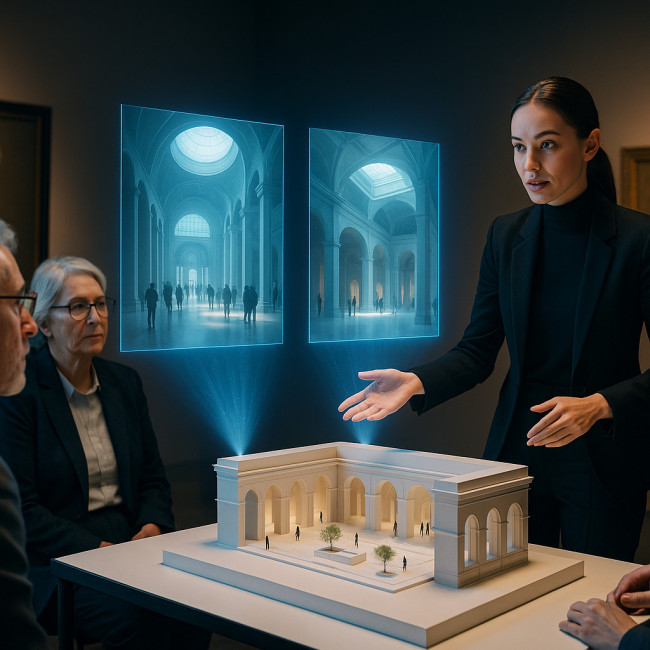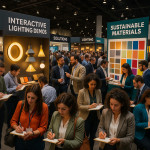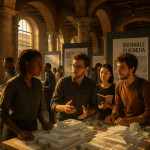Interior architect event checklist: pitch your concepts to museum curators
Ready to place your spatial concepts under the museum spotlights? Follow this actionable interior architect event checklist to win curators' hearts, secure exhibition space, and spark commissions that scale your practice.
Why interior architects should court museum curators
Museum teams constantly search for fresh spatial narratives that elevate visitor experience. When you host an event or micro-installation on their premises, you:
- Show live proof of your design thinking instead of sharing flat PDFs.
- Tap into qualified footfall; museum audiences already crave cultural storytelling.
- Earn press credit that boosts your profile on curated spatial-design listings.
The interior architect event checklist

From budgeting to visitor data, each of the ten checkpoints below distills years of gallery collaboration into a streamlined roadmap you can follow without second-guessing. By working through them in order, you will translate abstract sketches into curator-ready evidence, dodge common institutional red tape, and signal the professional rigour that museums look for when awarding scarce floor space. Keep this checklist open as you refine your pitch deck, schedule venue calls, and assemble a multidisciplinary team—every tick mark moves you closer to an opening night packed with critics, patrons, and future clients.
1 — Define a crisp curatorial angle
Curators green-light projects that align with their collection themes, annual programming, and community goals. Start by writing a one-sentence purpose statement. Example: “Transform dormant lobby zones into interactive wayfinding landscapes that shorten queue times.” Build every slide, material sample, and talking point around that anchor.
2 — Screen potential venues
Compare three to five museums that match your concept's scope and technical needs. Check previous spatial collaborations, load-in restrictions, and marketing reach. An email interview with the exhibition manager often reveals hidden criteria faster than browsing public specs.
3 — Quantify feasibility early
- Measure available square metres and ceiling heights.
- Request floor plans with services marked (power, sprinklers).
- Estimate traffic flow with visitor data. Tip: many French museums share statistics via the Ministry of Culture's open portal.
4 — Craft a curator-friendly pitch deck
Structure your deck in five lean sections:
- Problem: current visitor friction.
- Concept: 3-D visual plus 50-word narrative.
- User journey: diagram of before/after paths.
- Budget & timeline: ranges not guesses.
- Impact metrics: how you will track success.
Embed AR walkthroughs so curators preview ambience without scheduling on-site mock-ups.
5 — Prepare material samples
Museum conservation teams worry about emissions, off-gassing, and surface wear. Use the sustainable finishes guide to pre-label VOC scores, fire ratings, and cleaning protocols.
6 — Design an immersive micro-event
| Format | Visitor capacity | Duration | Pros | Cons |
|---|---|---|---|---|
| Panel talk + mock-up | 80 | 2 h | High knowledge transfer | Limited hands-on time |
| Pop-up installation | 300/day | 7 days | Extended exposure | Higher fabrication cost |
| VR kiosk demo | 500/day | 30 days | Low physical footprint | Tech maintenance needed |
7 — Lock sponsorship and insurance
Many museums ask guest designers to cover construction and liability. Negotiate in-kind support such as security staffing or press-office coverage. Verify professional liability insurance limits align with artwork valuations.
8 — Plan logistics backward from opening night
- Reserve freight elevator slots first—they disappear fast during exhibition change-overs.
- Co-draft risk assessment sheets with museum technicians.
- Tag every crate with humidity thresholds and handling icons.
9 — Activate visitor engagement
Add QR codes that unlock process videos or sustainability facts. Use inclusive wayfinding symbols drawn from the inclusive spatial design checklist so every visitor feels welcomed.
10 — Capture data for post-event ROI
Agree on metrics before launch: dwell time, self-guided tour downloads, social-media mentions. Post-event, send a one-page impact report to curators within two weeks; they will remember you next grant cycle.
Mini quiz — Test your curator-readiness
Pro tips to boost curator trust
Curators vet talent online before they reply. Stand out with:
- Updated directory listings. Refine tags using the interior architect directories workflow.
- Process-oriented case studies; show sketches, mock-ups, and visitor reactions.
- Press quotes from previous projects placed prominently in your bio.
FAQ
- How long in advance should I contact museum curators?
- For major institutions, start outreach nine to twelve months before your preferred launch date. Smaller local museums often confirm concepts within four to six months.
- Do I need a finished prototype before pitching?
- No. High-quality renders, material boards, and a clear impact statement suffice. Curators prefer flexibility to adjust the final build to site needs.
- Who pays for insurance during the event?
- Responsibility varies by venue. Many museums require guest designers to cover public liability, while the institution insures the building shell.
- Can I sell my services during the exhibition?
- Direct sales are rare in museums, yet you may leave discreet printed cards or embed a contact QR code at the exit point—always confirm with the exhibition manager.
Next step: turn your checklist into action
You now hold a curator-approved roadmap. Audit your upcoming calendar, book venue calls, and refine your pitch deck this week. Your future commissions are waiting the moment you step beyond the drawing board.
Ready to secure your first museum showcase? Download our editable event-planning template and start emailing curators today.











